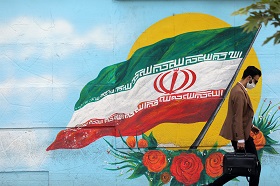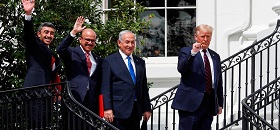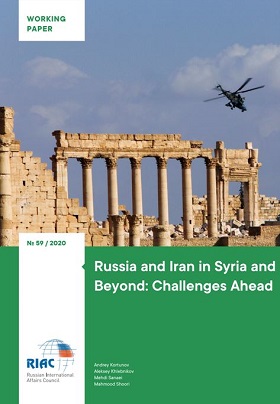Assessing Iran’s Threat Potential to the UAE
In
Login if you are already registered
(votes: 3, rating: 4.67) |
(3 votes) |
Ph.D., Researcher at TRENDS Research & Advisory in Abu Dhabi and an adviser at Gulf State Analytics (GSA), a Washington-based geopolitical risk consultancy
Iran condemned the United Arab Emirates for signing the Abraham Accords with Israel last August, with Kayhan Daily, the mouthpiece ultraconservatives in Iran, publicly warning the UAE that it is now “a legitimate and easy target.” Iranian Supreme Leader Ali Khamenei even Tweeted #UAEStabsMuslims on Sept. 1, in response to the deal. Subsequently, the Gulf Cooperation Council (GCC) Secretary General admonished Iran “for interfering in the domestic affairs of another country.”
Officials in the UAE have viewed Iran as a danger for many years, which is one of the reasons why Abu Dhabi lobbied the Trump administration to pursue “maximum pressure” against Tehran, and why Emirati leadership viewed the United States-Iran partial rapprochement during Obama’s presidency as a threat to its security interests.
Historical junctures such as the Iranian Revolution in 1979 have shaped perceptions of both sides. Iran’s actions often come from a siege mentality as they feel they are encircled by Sunni states that are supported by a strong U.S. military presence in the region [1]. From the UAE’s perspective, Iran’s export of revolutionary Shi’ism to countries such as Syria, Iraq, Lebanon, and Yemen has been accompanied by the establishment of a nuclear weapons program, and a territorial dispute over the Gulf islands Abu Musa, Greater Tunb, and Lesser Tunb. Iran’s ability to endanger critical sea choke points such as the Strait of Hormuz and the Bab al Mandab Strait has heightened tensions.
Various security analysts have warned that Iran’s threats to the Emirates are serious, but how serious are they? Is the threat level exaggerated, or is the perception of the threat misplaced? While Iran has been actively involved in conflicts across several Arab states such as Iraq, Syria, and Yemen, how realistic or probable is a direct Iranian attack against the UAE?
This analysis relies on expert commentary by scholars and analysts who specialize on Iran and Iranian security in particular. The general consensus among these experts is that while a full-scale attack cannot be theoretically excluded, the likelihood of an impending attack is very limited to highly unlikely. There are numerous factors as to why that is the case.
Lastly, there has been internal upheavals and economic problems plaguing Iran for many years. U.S.-imposed sanctions, which the Trump administration implemented after it unilaterally pulled Washington out of the Joint Comprehensive Plan of Action (JCPOA), have taken a huge toll on Iran’s economy and the day-to-day lives of ordinary Iranians. A recent Bloomberg News report indicates that the “…coronavirus outbreak—the worst in the region—has stretched its health system enormously at a time when money is extremely tight due to low oil exports and prices. The government has carved out 20% of the current annual budget to deal with the virus, is tapping an already depleted sovereign wealth fund for $1 billion, and is seeking to borrow from the IMF.” As a consequence, Iran’s national currency has plunged to its lowest point ever.
From the Iranian government’s perspective, any war with a foreign country—especially one that is a close partner with the U.S. and militarily strong on their own—would be devastating at this point. It is clear that Iran’s government, while intent to continue sponsoring non-state actors across the Middle East to advance its strategic objectives, is not interested in full-scale war.
The findings of a 2010 study still hold true today and are echoed by most analysts. “Iranian military doctrine is primarily defensive in nature and based on deterring perceived adversaries.” Iran will very likely rely on its proxy allies (Lebanese Hezbollah, Afghanistan’s Fatemiyoun Division etc.) in order to project its power and deter others from attacking its territory. Iran will engage in subversion, deception, and covert operations against its perceived adversaries since they are low-cost, high-yield strategies. Iranian leadership cannot succeed through direct confrontation against its regional adversaries and beyond, but must take a more indirect approach by creating confusion and disinformation about their capabilities and real intentions.
Iran condemned the United Arab Emirates for signing the Abraham Accords with Israel last August, with Kayhan Daily, the mouthpiece ultraconservatives in Iran, publicly warning the UAE that it is now “a legitimate and easy target.” Iranian Supreme Leader Ali Khamenei even Tweeted #UAEStabsMuslims on Sept. 1, in response to the deal. Subsequently, the Gulf Cooperation Council (GCC) Secretary General admonished Iran “for interfering in the domestic affairs of another country.”
Officials in the UAE have viewed Iran as a danger for many years, which is one of the reasons why Abu Dhabi lobbied the Trump administration to pursue “maximum pressure” against Tehran, and why Emirati leadership viewed the United States-Iran partial rapprochement during Obama’s presidency as a threat to its security interests.
Historical junctures such as the Iranian Revolution in 1979 have shaped perceptions of both sides. Iran’s actions often come from a siege mentality as they feel they are encircled by Sunni states that are supported by a strong U.S. military presence in the region [2]. From the UAE’s perspective, Iran’s export of revolutionary Shi’ism to countries such as Syria, Iraq, Lebanon, and Yemen has been accompanied by the establishment of a nuclear weapons program, and a territorial dispute over the Gulf islands Abu Musa, Greater Tunb, and Lesser Tunb. Iran’s ability to endanger critical sea choke points such as the Strait of Hormuz and the Bab al Mandab Strait has heightened tensions.
Various security analysts have warned that Iran’s threats to the Emirates are serious, but how serious are they? Is the threat level exaggerated, or is the perception of the threat misplaced? While Iran has been actively involved in conflicts across several Arab states such as Iraq, Syria, and Yemen, how realistic or probable is a direct Iranian attack against the UAE?
This analysis relies on expert commentary by scholars and analysts who specialize on Iran and Iranian security in particular. The general consensus among these experts is that while a full-scale attack cannot be theoretically excluded, the likelihood of an impending attack is very limited to highly unlikely. There are numerous factors as to why that is the case.
The Notion of Threat Perception
The calculus involved in assessing domestic threats requires an objective notion of whether a country is endangered as well as an understanding of subjective threats. States make decisions about their security by first looking at whether they are inflating the risk of a threat or if they are underestimating a perceived opponent. They then look at an opponent’s rhetoric to determine if their threats are serious or just serving as domestic propaganda.
As Ciovacco points out, it is important when exploring threat perception to pay careful attention to the difference between what leaders perceive as dangerous and what the evidence suggests [3]. In assessing Iranian military capabilities, Anthony Cordesman, a security expert at the Center for Strategic and International Studies (CSIS), cautions that countries such as Iran might be using deception and secrecy to mask the actual nature of their military prowess. “All of the major sources used in this analysis are careful to note that Iran conceals many of the details of its military developments, exaggerates some of its capabilities, and simultaneously is quietly making major improvements to many of its asymmetric warfare capabilities—particularly in its ability to influence foreign non-state actors.” [4]
Iranian Military Capability: More Defence than Offence
Iran has long provided financial and military support to a variety of non-state Islamist groups that are part of its so-called “peripheral strategy.” As Cordesman has stated: “Iran’s Expeditionary Capabilities to use regular military forces are limited, but Iran has a wide range of effective asymmetric forces.” 5
Another recent study conducted by CSIS’s Seth Jones asserts that “Iran has constructed more sophisticated and longer-range ballistic and cruise missiles and conducted missile attacks against countries such as Saudi Arabia. In addition, Iran has developed offensive cyber capabilities and used them against the United States and its partners.” [6] In 2016 the Supreme Leader mandated that Iran improve its defensive and offensive capabilities. Subsequently, its cyber capabilities were developed further and Iran has demonstrated the ability to deploy hackers to disrupt and attacks foreign targets. These types of attacks have a high disruptive potential and a fairly low economic cost [7]. Part of the calculation has become the probability of detection, attribution and retribution. In terms of its missiles program, Iran has increased the accuracy of its missiles systems as well as the missile range [8]. The missiles program is a key element in deterring adversaries, since its purpose is to raise significant costs of the conflict and giving adversaries pause as they contemplate directly targeting Iran [9].
Historically, Iranian foreign policy has been primarily based on “sources of caution and pragmatism” in its formulation. A RAND study supports this. “Our exploration of Iranian strategic thinking revealed that ideology and bravado frequently mask a preference for opportunism and realpolitik.” The paper claims: “… [Iran’s] revolutionary ideology has certainly featured prominently in the rhetoric of its officials. However, the record of Iranian actions suggests that these views should be more accurately regarded as the vocabulary of Iranian foreign policy rather than its determinant. Nationalism, sovereignty, and regime survival are the more fundamental drivers of Iran’s external behavior.” [10]
Only when a pre-emptive Israeli or U.S. strike against Iran will take place, one will almost certainly witness an Iranian retaliatory action against U.S. allies, with the UAE likely to be the first among these [11]. If, on the other hand, Iran attacks without provocation, it might only convince other Gulf states to jump on the normalization bandwagon with Israel.
There are significant limitations to Iran’s potential military threat to the UAE. For one, Iran has poor quality military equipment that would be effective for defensive purposes or as a deterrent, but is not geared towards an offensive assault on another country. Iran seems to have a manpower advantage, but this is not a decisive factor. The GCC has outspent Iran in terms of military equipment, and the UAE’s military arsenal is of far superior quality and sophistication. The U.S. has various security agreements and numerous military bases in the UAE and other GCC countries. The UAE’s close cooperation with the U.S. has been central to its military strategy. Approximately 5,000 military personnel are stationed at UAE facilities such as Jebel Ali, the air base in Al-Dhafra, and the port area of Fujairah.
Any attack directed at Emirati territory would trigger a U.S. military response. In the eventuality of an Iranian strike, it cannot rely on its traditional allies. Syria, for example, is still bogged down in conflict and under stringent U.S. sanctions, while Hezbollah is preoccupied with its own political challenges in Lebanon.
The Shi’a Crescent and Lack of Support for Iran amongst Arabs
This threat scenario is embedded in the longstanding Shi’a Crescent argument, the underlying argument of which is based on the notion that Shi’a power and ideology challenges the Sunni Arab world’s status quo. Commentators often couch the rivalry in sectarian terms. Shi’a Islam is practiced by about 10-15 percent of the total Muslim population, so Iran as a religious model has limited ideological appeal to the rest of the Arab world, especially since there are significant doctrinal differences within Shi’a Islam and many Shi’a Arabs do not look to the Islamic Republic for religious or political guidance [12]. Among GCC members, many of the Shi’a minorities are integrated into their respective national communities and generally their national identities and national loyalties tend to supersede any transnational affiliations. Shi’ism is not a cohesive block, and Iran cannot count on any significant religiously driven support in this matter [13].
The majority of Iran experts have long pointed out that the regime of the Islamic Republic is primarily interested in survival. While it frequently uses divisive and provocative rhetoric to posture for appeal in the Arab world, such as standing up for the Palestinian cause, it rarely follows up with any serious military action. It is safe to argue that the current Iranian leadership will not jeopardize their hold on power for an attack without a clear pretext or a defensive retaliation in response to a clear attack against Iranian territory [14].
Prohibitive Factors
One major reason why Iran will refrain from attacking the UAE is its significant commercial presence and business links, most of which are with Dubai. “Iran remains very heavily dependent on the UAE for its already dwindling trade,” says Kevjn Lim of Tel Aviv University’s School of Political Science, Government, and International Affairs. Between January and April of 2020, the UAE was Iran’s third-largest export market at $1.2bn (just after China at $2.5bn and Iraq at $2bn); in the 2019 fiscal year the number was $2.5bn, Iran’s second-largest. According to Iran’s Trade Promotion Organisation, 60 percent of Iran’s imports originated from China, the UAE, and Turkey combined; in 2019 those imports were worth $8.7bn.
Iran will not launch a military attack on the UAE, Lim believes, “but it may resort to subversion or sabotage. The UAE’s oil infrastructure or oil vessels come to mind…” [15].

Moscow and Tehran in Syria: Competition or Partnership?
Afshon Ostovar, of the Department of National Security Affairs, Naval Postgraduate School in the U.S. and author of Vanguard of the Imam: Religion, Politics, and Iran’s Revolutionary Guards is of the opinion that Iran will likely refrain from serious escalation, pending the results of the U.S. presidential elections. “I suspect Iran will keep its options open regarding the UAE in the short to medium term,” he says. “Much of Iran’s behavior will likely be shaped by the outcome of the upcoming election. For example, should there be a change in administration and a subsequent shift in American policy toward Iran, then that might mollify Iranian behavior for a period.”
Thomas Juneau from the University of Ottawa believes that a Biden presidency will very likely seek to revive the 2015 nuclear deal with Iran but it “…will not fundamentally transform dynamics in the Gulf, however: the U.S. and Iran will remain bitter rivals, and so will Saudi Arabia and Iran. That said, tension in the Gulf should slightly decrease, even if they will not disappear. The risk of a spark triggering an unwanted escalation will decrease, but it will not disappear. In this context, […] Iran [will] maintain the broad outline of its outlook towards the GCC, and to change only its tactics. It might, for example, seek to exploit differences within the GCC more than before by cooperating with those willing to do so (i.e., all except Saudi Arabia and Bahrain).” [16] A lot will also depend on the fierce competition inside Iran’s political establishment especially since the Supreme Leader is in poor health and there are speculations about his designated successor [17].
Iran bore no overt consequences for its attacks on Abqaiq and on ships in the Gulf waters, Ostovar notes, and that has likely only emboldened them to use such strategies. “The attacks of recent years were out-of-step considering Iran’s past behavior, but could become more commonplace as Iran continues to suffer from sanctions pressure.” [18]
Iran’s Perceptions of the UAE’s Military Accomplishments
Another deterrent in terms of Iran’s attack calculus is its assessment of Emirati military force.
In a recent study, Roberts (2020) points out that “…even before operations in Yemen, the UAE military…developed an axiomatic reputation as demonstrably the most proficient military in the Gulf region.” [19] The UAE stands out, in comparison to other Arab countries, for its modern, advanced weaponry, such as drones, missile-defense systems, and warships. Over the years, UAE forces have taken part in numerous offensive military deployments and exercises in such arenas as Bosnia, Afghanistan, and Libya. “[The country has allowed] its forces to train alongside important NATO counterparts to reach regionally unusual levels of combat efficiency, as demonstrated in the Yemen campaign and elsewhere.” A lot of this advance in military affairs is attributed to the UAE’s Crown Prince, Mohammed bin Zayed, who has “…overhauled state-wide military structures, amalgamated federal forces, redefined procurement approaches, and focused on creating pockets of military excellence in areas like the Presidential Guard, the Air Force, and the Joint Analysis Center.” [20]
The Danger of Overreaction

Political Transformations in Iran: How to Keep up with the Times
Lastly, there has been internal upheavals and economic problems plaguing Iran for many years. U.S.-imposed sanctions, which the Trump administration implemented after it unilaterally pulled Washington out of the Joint Comprehensive Plan of Action (JCPOA), have taken a huge toll on Iran’s economy and the day-to-day lives of ordinary Iranians. A recent Bloomberg News report indicates that the “…coronavirus outbreak—the worst in the region—has stretched its health system enormously at a time when money is extremely tight due to low oil exports and prices. The government has carved out 20% of the current annual budget to deal with the virus, is tapping an already depleted sovereign wealth fund for $1 billion, and is seeking to borrow from the IMF.” [21] As a consequence, Iran’s national currency has plunged to its lowest point ever.
From the Iranian government’s perspective, any war with a foreign country—especially one that is a close partner with the U.S. and militarily strong on their own—would be devastating at this point. It is clear that Iran’s government, while intent to continue sponsoring non-state actors across the Middle East to advance its strategic objectives, is not interested in full-scale war.
The findings of a 2010 study still hold true today and are echoed by most analysts. “Iranian military doctrine is primarily defensive in nature and based on deterring perceived adversaries.” [22] Iran will very likely rely on its proxy allies (Lebanese Hezbollah, Afghanistan’s Fatemiyoun Division etc.) in order to project its power and deter others from attacking its territory. Iran will engage in subversion, deception, and covert operations against its perceived adversaries since they are low-cost, high-yield strategies [23]. Iranian leadership cannot succeed through direct confrontation against its regional adversaries and beyond, but must take a more indirect approach by creating confusion and disinformation about their capabilities and real intentions.
References
Ciovacco, C. 2020. “The Shaping of Threat through Narration’, Journal of Strategic Security, Vol. 13, No.2, pp. 48-63
Connell, M. 2010. “Iran’s Military Doctrine,” in: Robin Wright ed. The Iran Primer. Power, Politics, and U.S. Policy. United Institute of Peace Press., Washington, D.C. pp.70-73
Cordesman, A. 2020. The Gulf and Iran’s Capabilities for Asymmetric Warfare. CSIS.
https://csis-website-prod.s3.amazonaws.com/s3fs-public/publication/200113_GULF_MILITARY_BALANCE.pdf.
Defense Intelligence Agency. 2019. Iran. Military Power. Ensuring Regime Survival and Securing Regional Dominance. U.S. Government Publishing Office, Washington, DC.
Eslami, M. and Alena Vysotskaya Guedes Vieira. 2020. “Iran’s strategic culture: the ‘revolutionary’ and ‘moderation’ narratives on the ballistic missiles programme,” Third World Quarterly, https://doi.org/10.1080/01436597.2020.1813562.
Gervais, Victor. 2018. Iran’s Missile Programmes: Evolving Strategic Objectives and Capabilities. EDA Insight, Research & Analysis. https://eda.ac.ae/docs/default-source/Publications/edainsight_iransmissileprogramme_en.pdf?sfvrsn=2.
Hicks, Kathleen and Melissa Dalton eds. 2017. Deterring Iran after the Nuclear Deal. Center for Strategic & International Studies. https://csis-website-prod.s3.amazonaws.com/s3fs-public/publication/170313_Hicks_DeterringIran_Web.pdf.
Ibish, Hussein. 2017. The UAE’s Evolving National Security Strategy. AGSIW, Washington, DC. https://agsiw.org/wp-content/uploads/2017/04/UAE-Security_ONLINE.pdf.
Jones, S. 2020. Containing Iran. Understanding Iran’s Power and Exploiting its Vulnerabilities. CSIS. https://csis-website-prod.s3.amazonaws.com/s3fs-public/publication/200110_Jones_ContainingIran_WEB_v2.pdf.
Kausch, K. 2017. ‘Cheap Havoc: How Cyber-Geopolitics Will Destabilize the Middle East’, The German Marshall Fund of the United States, Policy Brief, No.35, pp.1-10 https://www.gmfus.org/publications/cheap-havoc-how-cyber-geopolitics-will-destabilize-middle-east
Keynoush, B. 2020. 'Iran's Regional Dynamics: A Piecemeal approach' Middle East Policy, Volume XXVII, No. 2, Summer 2020, pp. 94-107
Lim, K. 2020. ‘Iran’s Grand Strategic Logic’ Survival, Vol. 62, no. 5, pp. 157-172
Motevalli, G. 2020. ‘What U.S. Sanctions Mean for Iran’s Corona Virus Fight’, Bloomberg News, April 6, https://www.bloomberg.com/news/articles/2020-04-06/what-u-s-sanctions-mean-for-iran-s-coronavirus-fight-quicktake.
Pahlavi, P. and Eric Quellet. 2019. ‘Iran: Asymmetric Strategy and Mass Diplomacy’ Journal of Strategic Security, Vol. 13, Number 2, pp. 94-106
Rahigh-Aghsan, A. and Peter Viggo Jakobsen. 2010. “The Rise of Iran: How Durable, How Dangerous?”, The Middle East Journal, Vol. 64, No. 4, pp. 559-573
Roberts, D. 2020. “Bucking the Trend: The UAE and the Development of Military Capabilities in the Arab World”, Journal of Security Studies, Vol. 29, Issue 2, pp. 301-334
Salisbury, P. 2020. Risk Perception and Appetite in the UAE Foreign and National Security Policy. Chatham House. https://www.chathamhouse.org/sites/default/files/2020-07-01-risk-in-uae-salisbury.pdf.
Tabatabai, A. 2019. Iran’s National Security Debate. Implications for Future U.S.-Iran Negotiations. RAND. https://www.rand.org/pubs/perspectives/PE344.html.
Tabatabai, A. 2020. ‘No Conquest-No Defeat-Iran’s National Security Strategy’. Oxford University Press.
Terhalle, M. 2007. ‘Are the Shia Rising?’ Middle East Policy, Vol. XIV, No.2, pp. 69-83.
Wehrey, F. et al. 2008. Dangerous but not Omnipotent: Exploring the Reach and Limitations of Iranian Power in the Middle East. RAND. https://www.rand.org/content/dam/rand/pubs/monographs/2009/RAND_MG781.pdf.
1. Pahlavi, P. and Eric Quellet. 2019. ‘Iran: Asymmetric Strategy and Mass Diplomacy’ Journal of Strategic Security, Vol. 13, Number 2, pp. 95.
2. Pahlavi, P. and Eric Quellet. 2019. ‘Iran: Asymmetric Strategy and Mass Diplomacy’ Journal of Strategic Security, Vol. 13, Number 2, pp. 95.
3. Ciovacco, C. 2020. “The Shaping of Threat through Narration’, Journal of Strategic Security, Vol. 13, No.2, pp. 48.
4. Cordesman, A. 2020. The Gulf and Iran’s Capabilities for Asymmetric Warfare. CSIS.p.42.
51. Ibid, p.42.
6. Jones, Seth E. 2020. Containing Iran. Understanding Iran’s Power and Exploiting its Vulnerabilities. CSIS, p.2.
7. Kausch, K. 2017. ‘Cheap Havoc: How Cyber-Geopolitics Will Destabilize the Middle East’, The German Marshall Fund of the United States, Policy Brief, No.35, pp.2.
8. Gervais, Victor. 2018. Iran’s Missile Programmes: Evolving Strategic Objectives and Capabilities. EDA Insight, Research & Analysis
9. Hicks, Kathleen and Melissa Dalton, eds. 2017. Deterring Iran after the Nuclear Deal. Center for Strategic & International Studies.
10. Wehrey, F. et al. 2008. Dangerous but not Omnipotent: Exploring the Reach and Limitations of Iranian Power in the Middle East. RAND, p.xvii.
11. Salisbury, Peter. 2020. Risk Perception and Appetite in the UAE Foreign and National Security Policy. Chatham House, p.18.
12. Terhalle, M. 2007. ‘Are the Shia Rising?’ Middle East Policy, Vol. XIV, No.2, pp. 74-80.
13. Rahigh-Aghsan, Ali and Peter Viggo Jakobsen. 2010. “The Rise of Iran: How Durable, How Dangerous?”, The Middle East Journal, Vol. 64, No. 4, pp. 563-64
14. See Keynoush, B. 2020. 'Iran's Regional Dynamics: A Piecemeal approach' Middle East Policy, Volume XXVII, No. 2, Summer 2020, pp. 94-107 and Tabatabai, A. 2020. ‘No Conquest-No Defeat-Iran’s National Security Strategy’. Oxford University Press.
15. Interview with Kevjn Lim, September 29, 2020.
16. Interview with Thomas Juneau, January 6, 2021.
17. Interview with Farhad Rezaei, January 14, 2021
18. Interview with Afshon Ostovar, October 7, 2020
19. Roberts, D. 2020. “Bucking the Trend: The UAE and the Development of Military Capabilities in the Arab World”, Journal of Security Studies, Vol. 29, Issue 2, pp. 315
20. Ibid, p. 321
21. Motevalli, G. 2020. ‘What U.S. Sanctions Mean for Iran’s Corona Virus Fight’, Bloomberg News, April 6, https://www.bloomberg.com/news/articles/2020-04-06/what-u-s-sanctions-mean-for-iran-s-coronavirus-fight-quicktake.
22. Connell, M. 2010. “Iran’s Military Doctrine,” in: Robin Wright ed. The Iran Primer. Power, Politics, and U.S. Policy. United Institute of Peace Press., Washington, D.C. p. 73
23. Tabatabai, A. 2019. Iran’s National Security Debate. Implications for Future U.S.-Iran Negotiations. RAND, p.8-10
(votes: 3, rating: 4.67) |
(3 votes) |
The American policy towards Syria is becoming increasingly irreversible
Moscow and Tehran in Syria: Competition or Partnership?The Russian’s view on Syria is tactical, not strategic
Peace in the Middle East: Are the Abraham Accords a Game-Changer in the Peace Process?The Accords are a real game-changer for the Middle East Peace Process, with their value lying in the precedent they created
Political Transformations in Iran: How to Keep up with the TimesSpecific features of its spiritual tradition, its values and the institutional framework permit the system to adapt to the changing social environment and allow for improvising when handling forms of political governance
How to End the War in Yemen in 2020?Yemenis themselves have no less rich potential for independent creative activity
Russia and Iran in Syria and Beyond: Challenges AheadRIAC and IRAS Working Paper #59/2020






